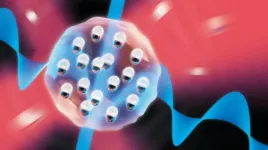(Press-News.org) LA JOLLA, CA—Scientists at La Jolla Institute for Immunology (LJI) have developed a new computational method for linking molecular marks on our DNA to gene activity. Their work may help researchers connect genes to the molecular "switches" that turn them on or off.
This research, published in Genome Biology, is an important step toward harnessing machine learning approaches to better understand links between gene expression and disease development.
"This research is about bringing a three-dimensional perspective to studying DNA modifications and their function in our genome," says LJI Associate Professor Ferhat Ay, Ph.D., who co-led the study with LJI Professor Anjana Rao, Ph.D.
Ay and Rao are working to pinpoint regions of the genome that contain molecular enhancers, or "switches," which fine tune the levels of gene expression and determine when and where genes will be on or off. This work requires researchers to develop computational tools that can harness complex genomic data and find which enhancers are connected to which genes.
For the new study, the LJI researchers employed machine learning tools called linear and graph neural networks to process genomic data and make these connections. Neural networks are computational tools modeled after how neurons in the brain process information and identify patterns. Graph neural networks are able to integrate 3D information, such as the DNA physical interactions inside the cell.
Edahí González-Avalos, Ph.D., spearheaded the development of this graph neural network as a UC San Diego graduate student jointly mentored by Rao and Ay at LJI. "We can use this to prioritize DNA interactions within the genome," says González-Avalos, who now works at Guardant Health.
The neural network goes to work
The researchers trained new neural networks that learn how the presence of an important DNA modification called 5hmC, either near the gene or far away from it, is related to gene expression activity. This attachment of a hydroxymethyl group to cytosine has been associated with enhancer activity.
In fact, 5hmC appears to have such an important influence on gene expression that scientists have termed 5hmC the "sixth letter" of the DNA alphabet alongside A, T, C, G, and an intermediate methylated form called 5mC (the fifth base). The conversion of 5mC to 5hmC on cytosine is associated with enhancer activity—the more 5hmC, the greater the level of enhancer activity.
In previous studies, researchers in the Rao Lab had discovered that the location of 5hmC in the genome changed depending on what cell types they were looking at—and what genes those cell types expressed. The actual DNA code would be the same, but 5hmC would be attached to the genome in different places in a liver cell versus a lung cell or a brain cell.
This 5hmC distribution controlled the expression of different gene sets in these different types of cells. The researchers had found that 5hmC attaches to regions of the genomes that work as enhancers—the same regions that help switch gene expression on and off—as well as to the genes themselves. These differences in active genes and enhancers are what distinguishes a liver cell from cells in the lung or neurons in the brain.
"The distribution of 5hmC differs from cell type to cell type," says Rao. "If you can tell where 5hmC is, you can infer what cell type is producing the DNA you are studying." For example, if a cell is a cancer cell, you can infer what type of cancer it is, even if it has metastasised (moved far away from) its original site in the body.
The new research method allows a simpler connection to be made between genes and enhancers than was possible with earlier methods.
"This paper was a proof-of-concept showing we could use these graph neural networks to predict interactions between genes and enhancers using 5hmC," says González-Avalos.
Ay says he was pleased to see how the neural network revealed connections between genes and 5hmC in far-away regions of the genome. These long-distance connections across the genome helped prioritize regions with the ability to enhance gene expression.
"What is exciting is that some of these distant enhancers are novel regulatory elements that have not been discovered before," says Ay.
Going forward, the researchers hope to take a closer look at 5hmC distribution to better understand enhancer and gene interactions in human cells. "This research was done with data from mouse cells," says Ay. "Next, we'd want to look at 5hmC and these interactions in immune cells and cancer cells from patients."
Hope for better cancer diagnostics
Just as in normal cells, 5hmC distribution differs between cancer cell types. This means the new LJI method may prove valuable for understanding the genetic mechanisms that drive cancer development.
Rao says the new method may also open the door to faster, more accurate cancer diagnoses.
Currently, it is very hard for scientists to analyze blood samples for signs of solid tumors in the body. "Solid tumor cells aren't usually available in the blood. What's available is DNA, and it's usually DNA that's been partially degraded," says Rao.
As Rao explains, doctors could help more patients—and potentially detect cancers earlier—if they could look beyond the DNA itself and analyze 5hmC distribution instead.
More work needs to be done before scientists have the tools for this kind of cancer detection, but Ay says the new work shows the power of combining experimental data with new computational methods. "This suggests that by applying our new method we can identify new and unannotated distant enhancers," says Ay.
Additional authors of the study, "Predicting gene expression state and prioritizing putative enhancers using 5hmC signal," include Atsushi Onodera and Daniela Samaniego-Castruita.
This research was supported by the University of California Institute for Mexico and the United States and an El Consejo Nacional de Ciencia y Tecnología (UCMEXUS/CONACYT) pre-doctoral fellowship, the National Institutes of Health (grants R35 GM128938, R01 AI040127, AI109842, U01 DE28277, R35 CA210043, and R01 CA247500), and a funding agreement between La Jolla Institute and Kyowa Kirin/LJI.
DOI: 10.1186/s13059-024-03273-z
About La Jolla Institute
The La Jolla Institute for Immunology is dedicated to understanding the intricacies and power of the immune system so that we may apply that knowledge to promote human health and prevent a wide range of diseases. Since its founding in 1988 as an independent, nonprofit research organization, the Institute has made numerous advances leading toward its goal: life without disease. Visit lji.org for more information.
END
LJI scientists develop new method to match genes to their molecular 'switches'
New research may help scientists hunt down solid tumors and better diagnose disease
2024-06-03
ELSE PRESS RELEASES FROM THIS DATE:
The coldest lab in New York has a new quantum offering
2024-06-03
There’s a hot new BEC in town that has nothing to do with bacon, egg, and cheese. You won’t find it at your local bodega, but in the coldest place in New York: the lab of Columbia physicist Sebastian Will, whose experimental group specializes in pushing atoms and molecules to temperatures just fractions of a degree above absolute zero.
Writing in Nature, the Will lab, supported by theoretical collaborator Tijs Karman at Radboud University in the Netherlands, has successfully created a unique quantum state of matter called a Bose-Einstein Condensate (BEC) out of molecules.
Their BEC, cooled ...
Altered carbon points toward sustainable manufacturing
2024-06-03
By Shawn Ballard
The recent spike in food prices isn’t just bad news for your grocery bill. It also impacts the sugars used in biomanufacturing, which, by the way, isn’t quite as green as scientists and climate advocates expected. Surging prices and increasing urgency for genuinely sustainable manufacturing has pushed researchers to explore alternative feedstocks.
Feng Jiao, the Elvera and William R. Stuckenberg Professor in in the McKelvey School of Engineering at Washington University in St. Louis, developed a two-step process to convert carbon dioxide ...
Telemedicine may increase endocrinology care access for under-resourced patients with diabetes and heart disease
2024-06-03
BOSTON—Widespread availability of telemedicine during the pandemic led to more equitable access to endocrinology care for patients with type 2 diabetes and heart disease, according to a study being presented Monday at ENDO 2024, the Endocrine Society’s annual meeting in Boston, Mass.
Patients who benefited included those living in rural areas and in neighborhoods with lower socioeconomic status, according to the study.
While most adults with type 2 diabetes receive care in the primary care setting, adults who have both type 2 diabetes and cardiovascular disease ...
Exploration of enzyme-polymer interactions is a crucial first step toward the development of next-gen degradable wound coverings
2024-06-03
Imagine you’re deep in the backcountry on a hiking trip, and you fall and rip a deep gash in your lower leg. You’re a two-day walk away from proper treatment. After you stop the bleeding, your concern becomes keeping the wound clean.
Now, imagine you had just the thing in your first aid kit—a spray-on bandage embedded with a mild painkiller and a disinfectant. A bandage meant to deliver relief, and degrade within 48 hours, giving you time to make it to the hospital.
That’s one reality that Whitney Blocher McTigue, an assistant professor ...
Pudukotai Dinakarrao receives funding for continuous and lightweight authentication for wearable and portable embedded systems
2024-06-03
Sai Manoj Pudukotai Dinakarrao, Assistant Professor, Electrical and Computer Engineering, received funding for the project: “CLAWS: Continuous and Lightweight Authentication for Wearable and Portable Embedded Systems.”
“The target of this funding is to accelerate the transition of technology,” Pudukotai Dinakarrao said.
Using this proposed authentication technique, Pudukotai Dinakarrao will collect the gait signal of a user continually using a lightweight always-on sensing methodology. The collected gait signal will be analyzed through resource-aware dynamic early-exit neural networks (EENets) for authentication.
The proposed technique ...
Most surface ozone contributing to premature mortality in European countries is imported
2024-06-03
Exposure to current levels of ground-level ozone (O3) in Europe is one of the main causes of premature mortality due to air pollution, especially in summer. A study led both by the Barcelona Institute for Global Health (ISGlobal), a centre supported by the "la Caixa" Foundation, in collaboration with the French National Institute of Health and Medical Research (Inserm), and the Barcelona Supercomputing Center - Centro Nacional de Supercomputación (BSC-CNS), has quantified for the first ...
The integration of clinical trials with the practice of medicine
2024-06-03
About The Study: This article discusses the need for better integration of clinical trials and health care delivery enterprises.
Corresponding Author: To contact the corresponding author, Derek C. Angus, M.D., M.P.H., email angusdc@pitt.edu.
To access the embargoed study: Visit our For The Media website at this link https://media.jamanetwork.com/
(doi:10.1001/jama.2024.4088)
Editor’s Note: Please see the article for additional information, including other authors, author contributions and affiliations, conflict ...
Fresh findings: Earliest evidence of life-bringing freshwater on Earth
2024-06-03
New Curtin-led research has found evidence that fresh water on Earth, which is essential for life, appeared about four billion years ago - five hundred million years earlier than previously thought.
Lead author Dr Hamed Gamaleldien, Adjunct Research Fellow in Curtin’s School of Earth and Planetary Sciences and an Assistant Professor at Khalifa University, UAE, said by analysing ancient crystals from the Jack Hills in Western Australia’s Mid West region, researchers have pushed back the timeline ...
Study finds people of color disproportionately dropped from Medicaid
2024-06-03
The COVID-19 pandemic dramatically improved health insurance coverage for millions of Americans who were automatically covered by Medicaid due to the national public health emergency.
With the end of the emergency in April 2023, about 10 million people lost coverage as states began redetermining eligibility. However, an estimated three-quarters of disenrollments occurred not because states decided they were ineligible, but rather due to procedural reasons. These process-related issues could include enrollees not receiving ...
Weight indices, cognition, and mental health from childhood to early adolescence
2024-06-03
About The Study: Lower cognitive performance and greater psychopathology at baseline were associated with increased weight gain as children entered adolescence, and higher baseline body mass index was associated with more depressive symptoms over time. These longitudinal findings highlight the importance of cognitive and mental health to children’s healthy weight development and suggest that clinicians should monitor children with overweight or obesity for increased depression problems.
Corresponding Author: To contact the corresponding author, Tamara Hershey, Ph.D., email tammy@wustl.edu.
To access the embargoed study: Visit our For The Media ...
LAST 30 PRESS RELEASES:
New modeling approach sheds light on rare gut disease
Study documents potentially hazardous flame retardants in firefighter gear
Can certain bacteria regulate aging of the immune system and its related alterations?
AI model helps diagnose often undetected heart disease from simple EKG
There are fewer online trolls than people think
Cell membrane fluctuations produce electricity
Jeonbuk National University study shows positive parenting can protect adolescents against self-harm
Surface-engineered ZnO nanocrystals to tackle perfluoroalkyl substance contamination
This new understanding of T cell receptors may improve cancer immunotherapies
A new fossil face sheds light on early migrations of ancient human ancestor
A new immunotherapy approach could work for many types of cancer
A new way to diagnose deadly lung infections and save lives
40 percent of MRI signals do not correspond to actual brain activity
How brain-inspired algorithms could drive down AI energy costs
Gum disease may be linked to plaque buildup in arteries, higher risk of major CVD events
Contrails are a major driver of aviation’s climate impact
Structure of dopamine-releasing neurons relates to the type of circuits they form for smell-processing
Reducing social isolation protects the brain in later life
Keeping the heart healthy increases longevity even after cancer
Young adults commonly mix cannabis with nicotine and tobacco
Comprehensive review illuminates tau protein's dual nature in brain health, disease, and emerging psychiatric connections
Book prepares K-12 leaders for the next public health crisis
Storms in the Southern Ocean mitigates global warming
Seals on the move: Research reveals key data for offshore development and international ecology
Sports injuries sustained during your period might be more severe
World's first successful 2 Tbit/s free-space optical communication using small optical terminals mountable on satellites and HAPS
Can intimate relationships affect your heart? New study says ‘yes’
Scalable and healable gradient textiles for multi‑scenario radiative cooling via bicomponent blow spinning
Research shows informed traders never let a good climate crisis go to waste
Intelligent XGBoost framework enhances asphalt pavement skid resistance assessment
[Press-News.org] LJI scientists develop new method to match genes to their molecular 'switches'New research may help scientists hunt down solid tumors and better diagnose disease




